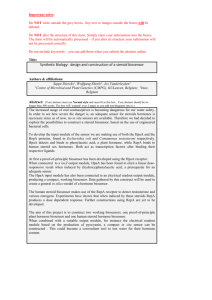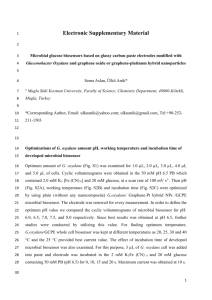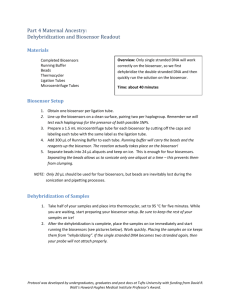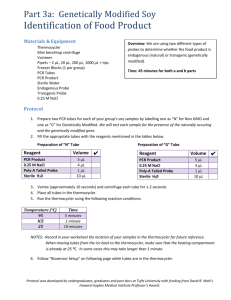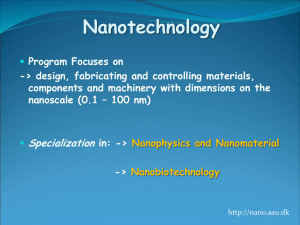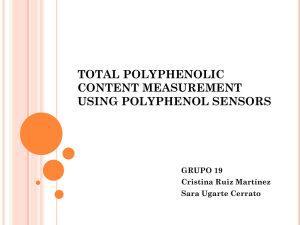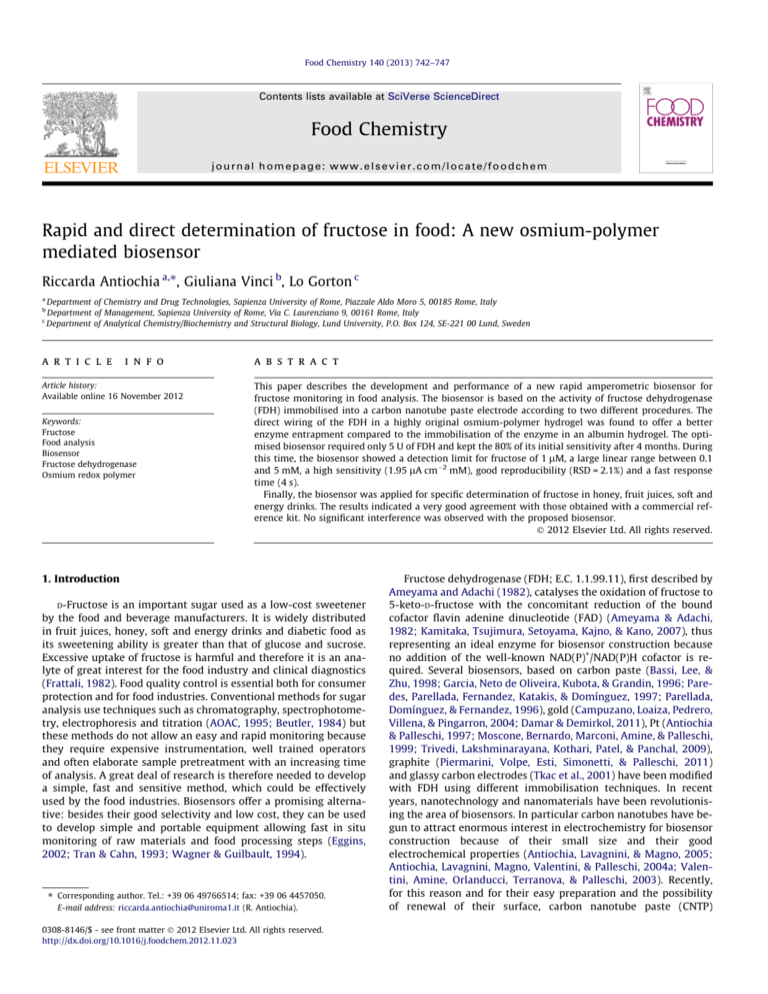
Food Chemistry 140 (2013) 742–747
Contents lists available at SciVerse ScienceDirect
Food Chemistry
journal homepage: www.elsevier.com/locate/foodchem
Rapid and direct determination of fructose in food: A new osmium-polymer
mediated biosensor
Riccarda Antiochia a,⇑, Giuliana Vinci b, Lo Gorton c
a
Department of Chemistry and Drug Technologies, Sapienza University of Rome, Piazzale Aldo Moro 5, 00185 Rome, Italy
Department of Management, Sapienza University of Rome, Via C. Laurenziano 9, 00161 Rome, Italy
c
Department of Analytical Chemistry/Biochemistry and Structural Biology, Lund University, P.O. Box 124, SE-221 00 Lund, Sweden
b
a r t i c l e
i n f o
Article history:
Available online 16 November 2012
Keywords:
Fructose
Food analysis
Biosensor
Fructose dehydrogenase
Osmium redox polymer
a b s t r a c t
This paper describes the development and performance of a new rapid amperometric biosensor for
fructose monitoring in food analysis. The biosensor is based on the activity of fructose dehydrogenase
(FDH) immobilised into a carbon nanotube paste electrode according to two different procedures. The
direct wiring of the FDH in a highly original osmium-polymer hydrogel was found to offer a better
enzyme entrapment compared to the immobilisation of the enzyme in an albumin hydrogel. The optimised biosensor required only 5 U of FDH and kept the 80% of its initial sensitivity after 4 months. During
this time, the biosensor showed a detection limit for fructose of 1 lM, a large linear range between 0.1
and 5 mM, a high sensitivity (1.95 lA cm2 mM), good reproducibility (RSD = 2.1%) and a fast response
time (4 s).
Finally, the biosensor was applied for specific determination of fructose in honey, fruit juices, soft and
energy drinks. The results indicated a very good agreement with those obtained with a commercial reference kit. No significant interference was observed with the proposed biosensor.
Ó 2012 Elsevier Ltd. All rights reserved.
1. Introduction
D-Fructose is an important sugar used as a low-cost sweetener
by the food and beverage manufacturers. It is widely distributed
in fruit juices, honey, soft and energy drinks and diabetic food as
its sweetening ability is greater than that of glucose and sucrose.
Excessive uptake of fructose is harmful and therefore it is an analyte of great interest for the food industry and clinical diagnostics
(Frattali, 1982). Food quality control is essential both for consumer
protection and for food industries. Conventional methods for sugar
analysis use techniques such as chromatography, spectrophotometry, electrophoresis and titration (AOAC, 1995; Beutler, 1984) but
these methods do not allow an easy and rapid monitoring because
they require expensive instrumentation, well trained operators
and often elaborate sample pretreatment with an increasing time
of analysis. A great deal of research is therefore needed to develop
a simple, fast and sensitive method, which could be effectively
used by the food industries. Biosensors offer a promising alternative: besides their good selectivity and low cost, they can be used
to develop simple and portable equipment allowing fast in situ
monitoring of raw materials and food processing steps (Eggins,
2002; Tran & Cahn, 1993; Wagner & Guilbault, 1994).
⇑ Corresponding author. Tel.: +39 06 49766514; fax: +39 06 4457050.
E-mail address: riccarda.antiochia@uniroma1.it (R. Antiochia).
0308-8146/$ - see front matter Ó 2012 Elsevier Ltd. All rights reserved.
http://dx.doi.org/10.1016/j.foodchem.2012.11.023
Fructose dehydrogenase (FDH; E.C. 1.1.99.11), first described by
Ameyama and Adachi (1982), catalyses the oxidation of fructose to
5-keto-D-fructose with the concomitant reduction of the bound
cofactor flavin adenine dinucleotide (FAD) (Ameyama & Adachi,
1982; Kamitaka, Tsujimura, Setoyama, Kajno, & Kano, 2007), thus
representing an ideal enzyme for biosensor construction because
no addition of the well-known NAD(P)+/NAD(P)H cofactor is required. Several biosensors, based on carbon paste (Bassi, Lee, &
Zhu, 1998; Garcia, Neto de Oliveira, Kubota, & Grandin, 1996; Paredes, Parellada, Fernandez, Katakis, & Domínguez, 1997; Parellada,
Domínguez, & Fernandez, 1996), gold (Campuzano, Loaiza, Pedrero,
Villena, & Pingarron, 2004; Damar & Demirkol, 2011), Pt (Antiochia
& Palleschi, 1997; Moscone, Bernardo, Marconi, Amine, & Palleschi,
1999; Trivedi, Lakshminarayana, Kothari, Patel, & Panchal, 2009),
graphite (Piermarini, Volpe, Esti, Simonetti, & Palleschi, 2011)
and glassy carbon electrodes (Tkac et al., 2001) have been modified
with FDH using different immobilisation techniques. In recent
years, nanotechnology and nanomaterials have been revolutionising the area of biosensors. In particular carbon nanotubes have begun to attract enormous interest in electrochemistry for biosensor
construction because of their small size and their good
electrochemical properties (Antiochia, Lavagnini, & Magno, 2005;
Antiochia, Lavagnini, Magno, Valentini, & Palleschi, 2004a; Valentini, Amine, Orlanducci, Terranova, & Palleschi, 2003). Recently,
for this reason and for their easy preparation and the possibility
of renewal of their surface, carbon nanotube paste (CNTP)
R. Antiochia et al. / Food Chemistry 140 (2013) 742–747
electrodes have started to become popular for electrode modification (Antiochia, Lavagnini, & Magno, 2004b; Gooding, 2005; Wang,
2005).
The objective of the present work is to report a new alternative
biosensor for fructose detection based on the modification of a
CNTP electrode with an osmium redox polymer. The efficient electron shuttling properties of the osmium redox polymer allowed its
utilisation for electrical wiring of cells and enzymes (Timur, Yigzae,
& Gorton, 2006b; Timur et al., 2006a) and for biosensor construction (Antiochia & Gorton, 2007; Heller, 1992; Heller & Feldman,
2008).
In our work the osmium redox polymer was used as redox
mediator to shuttle the electrons between the immobilised enzyme and the single-walled carbon nanotube paste (SWCNTP)
electrode and also as a support for direct wiring of FDH itself into
the paste by using poly(ethylene glycol) diglycidyl ether (PEDGE)
as a cross-linking agent. As well as optimisation studies, application of the proposed biosensor for fructose analysis in real samples
were carried out and the results obtained were in good agreement
with those determined with the standard spectrophotometric
method.
2. Experimental
2.1. Chemicals
Fructose dehydrogenase (FDH) (E.C. 1.1.1.47) from Gluconobacter sp. and D-fructose were purchased from Sigma (St. Louis, MO,
USA). Poly(ethylene glycol) (400) diglycidyl ether (PEDGE) was obtained from Polyscience (Warrington, PA, USA). Poly(1-vinylimidazole)12-[osmium(4,40 -dimethyl-2,20 -dipyridyl)2Cl2]2+/+ (osmium
redox polymer) was generously provided as a gift from ThereSense
Inc. (Alameda, CA, USA). Single-walled carbon nanotubes Carbolex
(diameter 1–2 lm) were obtained from Aldrich (Steinheim,
Germany). Mineral oil was obtained from Fluka (Buchs, Switzerland).
All other chemicals were from Carlo Erba (Milan, Italy). All solutions
were prepared with high purity water produced by a Milli-Q System
(Millipore, Bedford; MA, USA).
2.2. Construction of the Os-polymer modified CNTP electrode
The CNTP electrodes were prepared by hand-mixing SWCNTs
and graphite powder with mineral oil at a 60:40% ratio (w/w)
(Valentini et al., 2003). The paste was mixed in a mortar and
packed into a cavity (3 mm diameter, 0.5 mm depth) at the end
of a Teflon tube and electrical contact was established via a copper
wire connected to the paste. The electrode surface was gently
smoothed by rubbing it on a piece of filter paper before use.
The Os-polymer CNTP electrode was prepared by depositing on
the CNTP electrode surface 10 lL of a solution (10 mg/mL) of the
Os-polymer in Milli-Q water and 1 lL of an aqueous solution
(2.5 mg/mL) of the cross-linker agent PEDGE (Antiochia & Gorton,
2007). After the deposition, the electrodes were left to dry overnight at room temperature.
2.3. Construction of the modified CNTP fructose biosensor
The fructose biosensor was assembled according to two different procedures of FDH immobilisation. In the first procedure FDH
was immobilised in an albumin hydrogel. A 5 mg aliquot of albumin (BSA) was dissolved in 40 lL of 0.1 mol/L phosphate buffer
with 10 lL of a solution of FDH (10 U). A 25 lL aliquot of the
FDH-matrix system was successively mixed with 3 lL of glutaraldehyde (0.25% v/v) and entrapped between two polycarbonate
membranes and fixed to the surface of the Os-polymer CNTP
743
Fig. 1. Schematic representation of the FDH wiring through redox hydrogel of
Os-polymer on CNTP electrode.
electrode. A 0.1 M phosphate buffer solution was used to gently
rinse the biosensor and remove those of the glutaraldehyde molecules, which did not react with the polymeric matrix.
In the second procedure FDH was directly wired into the Ospolymer hydrogel. This method involved a thorough mixing of
10 lL of a solution of the Os-polymer (10 mg/ml) in Milli-Q water,
1 lL of an aqueous solution of PEDGE (2.5 mg/mL) and 10 lL of a
solution of FDH (10 U). Successively, a 10 lL aliquot of this solution
was deposited on the CNTP electrode surface and left to dry overnight at room temperature (Antiochia & Gorton, 2007). The modified electrode was rinsed carefully with 0.1 mol/L phosphate buffer
at pH 7.0 before use. A schematic representation of the wiring of
FDH through the Os-polymer redox hydrogel on the CNTP electrode is shown in Fig. 1.
2.4. Electrochemical characterization
Electrochemical measurements were performed using an Autolab electrochemical system equipped with PGSTS-12 with GPES
software (Eco Chemie, Utrecht, The Netherlands). All electrochemical experiments were carried out in a conventional three-electrode cell at room temperature with the modified CNTP electrode
(3 mm diameter) as working electrode, an Ag|AgCl/KCl(sat) as the
reference and a platinum wire as the counter electrode. The electrochemical cell contained 10 mL of 0.1 M phosphate buffer or
0.1 M acetate buffer at various pHs. A fixed potential, +200 mV versus Ag|AgCl, was used to make the amperometric experiments.
2.5. Biosensor response
For fructose determinations aliquots of a stock solution of
in 0.1 M acetate buffer at pH 5.0 were successively
added in the electrochemical cell and the steady-state current values were recorded. The steady-state current was achieved within
20–25 s.
D-fructose
2.6. Analysis of food samples
The fructose biosensor was tested for the analysis of food samples like honey and some beverages, like fruit juice, soft and energy
drinks, purchased from local supermarkets. Fructose concentrations in real samples were determined in five replicates on the basis of the calibration curve obtained for the standard fructose
solution. The results obtained were compared with those obtained
with the enzymatic spectrophotometric assay kit (Mannheim,
Germany, Cat.N. 139106). The determination of fructose is related
to the amount of NADPH formed and spectrophotometrically measured at 340 nm. Honey and beverage samples did not require any
pretreatment. The honey samples were diluted as follows: 1 g of
744
R. Antiochia et al. / Food Chemistry 140 (2013) 742–747
each sample was accurately weighed and dissolved in 100 mL
of water (1% solution) after heating for 15 min at t = 60 °C.
Then 50 lL of this solution were added to the cell containing
10 mL of buffer. The beverage samples were analysed by adding
50 lL directly to the electrochemical cell containing 10 mL of
buffer.
1.0
0.6
b
0.4
i / µA
3. Results and discussion
c
0.8
0.2
a
0.0
The principle of operation of the fructose biosensor is based on
the oxidation of D-fructose to 5-keto-D-fructose by FDH with the
concomitant reduction of the osmium-polymer mediator (Reaction
(1)) according to the following reactions:
FDH
D fructose þ 2Os3þ ! 5 keto D fructose þ 2Hþ þ 2Os2þð1Þ
2þ
2Os
CNTPelectrode
!
þ200mV vs:AgjAgCl
3þ
2Os
þ 2e
ð2Þ
The reduced mediator is successively reoxidized at the CNTP
electrode at a potential of +200 mV (Reaction (2)). The current values due to the enzymatic reaction are proportional to the concentration of fructose in the reaction medium for fructose
concentrations lower than the Michaelis–Menten constant. The
simplified reaction sequence of this biosensor given by Reactions
(1) and (2) is due to the characteristics of FDH enzyme, which contains the FAD cofactor tightly bound to the enzyme and does not
require the adding of NAD+ as most other dehydrogenase enzymes
thus allowing the construction of oxygen independent reagentless
sensors (Davidson & Jones, 1991). The structure of the mediator is
shown in Fig. 2. However, FDH also contains 3 hemes connecting
the FAD in the catalytic site with the surface of the enzyme (Ameyama & Adachi, 1982; Kamitaka et al., 2007). In previous work with
a similar enzyme, cellobiose dehydrogenase, it was shown that an
Os-polymer could connect both the FAD in the catalytic dehydrogenase domain as well as the heme in the separate cytochrome
domain (Tasca et al., 2009). Thus it can be expected that the
Os-polymer accepts electrons directly from the FAD in the active
site as well as from the hemes.
3.1. Electrochemical characterization of the FDH/Os-polymer/CNTP
electrode
The electrochemical behaviour of a similar Os-polymer CNTP
electrode was already investigated in our previous work (Antiochia
& Gorton, 2007). Fig. 3 shows a cyclic voltammogram obtained with
the Os-polymer CNTP modified electrode at a scan rate of 10 mV/s
in the absence (curve a) and in the presence (curves b and c) of
Fig. 2. The chemical structure of poly(1-vinylimidazole)12-[osmium(4,40 -dimethyl2,20 -bipyridyl)2Cl2]2+/+ (osmium redox polymer).
-0.2
-0.4
-0.6
-0.4
-0.2
0.0
0.2
0.4
0.6
E (Ag/AgCl) / V
Fig. 3. Cyclic voltammograms obtained with a FDH-Os-polymer modified CNTP
electrode in the absence (a) and in the presence of 5 103 M fructose concentration with FDH immobilised in an albumin hydrogel (b) and directly into the
Os-polymer hydrogel (c). Applied potential: 0.2 V (vs. Ag/AgCl). Experimental
conditions: Os-polymer: 10 lL of a 10 mg/mL solution; PEDGE: 1 lL of a 2.5 mg/mL
solution; BSA: 5 mg in 50 lL; glutaraldehyde: 3 lL of a solution 0.25% v/v; FDH: 5U;
m = 10 mV/s; 0.1 M phosphate buffer pH 7.0; electrode diameter: 3 mm.
FDH. As expected, a small peak separation typical of surface-bound
species is shown by all voltammograms, showing that FDH does not
influence the electrochemical behaviour of the modified electrode.
The formal redox potential of the Os-polymer was found to be of
about +180 mV vs. Ag|AgCl, in good agreement with that already reported previously (Antiochia & Gorton, 2007; Timur et al., 2006a;
Timur et al., 2006b). The proper working potential for the biosensor
was therefore choosen at +200 mV. It is interesting to note that
when the enzyme is wired to the Os-polymer hydrogel the current
observed (curve c) is higher than that registered when the enzyme
is entrapped in an albumin hydrogel matrix (curve b). This behaviour can be explained by the fact that the immobilisation of the enzyme with the Os-polymer hydrogel allows a larger number of
molecules of mediator in direct contact with the electrode surface
and therefore a stronger catalytic effect of FDH is observed with this
type of immobilisation.
3.2. Fructose biosensor response
In order to optimise the FDH-Os-polymer CNTP biosensor two
different immobilisation methods were tested. Fig. 4 shows the
fructose calibration curves derived from the amperometric response and relative to an Os-polymer CNTP electrode with FDH
immobilised into an albumin hydrogel matrix. The effect of enzyme loading on the current response of the biosensor was investigated in the range from 2 to 10 U of FDH. All curves showed a
linear part at the beginning with a deviation from linearity at higher fructose concentrations. This behaviour is probably due to the
saturation of the active site of the enzyme. As for the FDH amount
employed, the current gradually increased with increasing FDH
values from 2 to 5 U (curves a and b) but it did not show any significant increase for amounts higher than 5 U (curve c). This fact
indicates that the amount of enzyme is rate limiting at quite low
enzyme amounts employed but then the rate of the reaction becomes limited by other factors. Fig. 5 shows the fructose calibration curves obtained with the Os-polymer CNTP electrode with
FDH directly wired to the Os-polymer hydrogel. As can be seen,
the calibration curves show plateau current values, which are
about 20% higher than those obtained with FDH immobilised into
the albumin hydrogel, for all amounts of FDH employed. Once
745
R. Antiochia et al. / Food Chemistry 140 (2013) 742–747
1.0
b
0.8
c
i (µA)
0.6
a
0.4
0.2
0.0
0
5
10
15
20
25
30
[fructose] (mM)
Fig. 4. Calibration graphs for the fructose biosensor with the following FDH
amounts immobilised into an albumin hydrogel matrix: 2 U (a); 5 U (b); 10 U (c).
R.S.D. values calculated for each point of the calibration curves are between 1% and
3.1% (n = 6). Applied potential: 0.2 V (vs. Ag/AgCl). Experimental conditions: as in
Fig. 3.
1.2
explained by the fact that the enzyme is now wired through the redox hydrogel of the Os-polymer onto the CNTP electrode surface.
The hydrogel allows the immobilisation of the enzyme without
suffering major structural changes or loss of activity but at the
same time the high surface area of the SWCNTs allows a bigger
exposure of the enzyme’s catalytic sites as well as a high loading
of FDH with a possible enhancement of the resulting signal.
Fig. 5 shows the calibration curve for fructose registered by the
optimised biosensor and in the inset it is possible to see the linear
part of the calibration curve. It shows a good linearity over the range
of 0.1–5 mM. At higher fructose concentrations the curve becomes
nonlinear approaching a saturation value (KM = 3.66 mM). Statistical analysis gave the following equation y = 0.14x + 5.24 103
(r = 0.9992, n = 6), where y indicates the current (lA) and x the fructose concentration (mM). The sensitivity was found to be
1.95 lA cm2 mM and the detection limit was found to be about
1 lM, calculated using the relation 3S.D.a/b, where S.D.a is the absolute standard deviation of the intercept and b the slope of the calibration curve.
The biosensor showed also a fast response time of about 4 s.
In the literature several FDH biosensors based on platinum,
glassy carbon and carbon paste electrodes have been reported.
The comparison of some analytical characteristics of the previously
reported FDH biosensors and the proposed biosensor was given in
Table 1.
b
1.0
c
3.3. Effect of pH and temperature
0.8
i (µA)
a
0.6
0,8
0,6
i (µA)
0.4
0,4
0,2
0.2
0,0
0
1
2
3
4
5
6
[fructose] (mM)
0.0
0
5
10
15
20
25
30
[fructose] (mM)
Fig. 5. Calibration graphs for the fructose biosensor with the following FDH
amounts directly immobilised into the Os-polymer hydrogel: 2 U (a); 5 U (b); 10 U
(c). The inset shows the linear part of curve b. RSD% values calculated for each point
of the calibration curves are between 0.8% and 3% (n = 6). Applied potential: 0.2 V
(vs. Ag/AgCl). Experimental conditions: as in Fig. 3.
again, an amount of 5 U of FDH was found to give the maximum
current (curve b) and therefore 5 U of FDH was used to prepare
the biosensor in further experiments. The results obtained can be
The influence of the pH solution on the biosensor response for
fructose was investigated in the pH range between 4 and 5.5 in
0.1 M acetate buffer and in the range between 6 and 7.5 in 0.1 M
phosphate buffer. As shown in Fig. 6, the relative response is enhanced by increasing the solution pH from 4 to 5, reaching the
maximum value in acetate buffer at pH 5.0, which was subsequently utilised for further experiments. At pH values higher than
6 a progressive marked decrease of the relative response is registered and at pH values higher than 7.0 a loss of response of about
80% is observed. This result is in good agreement with those obtained in literature for FDH modified electrodes (Antiochia et al.,
2004b; Trivedi et al., 2009) and with the optimum pH of the
free enzyme, which is 4.5 (Ameyama, Shinagawa, Matsushita,
and Adachi (1981)).
The effect of the temperature of the buffer solution on the response of the sensor was studied in the range 10–40 °C and is reported in Fig. 7. As can be observed, the relative response
initially increases with the temperature up to a maximum value
at about 30 °C and decreases after a further increase. This behaviour can be attributed to thermal inactivation of FDH at higher
temperatures. However, a temperature of 25 °C, at which only a
Table 1
Comparison of analytical characteristics of various FDH-modified electrodes reported in literature.
a
b
c
d
Electrode configuration
Mediator
Linear range
LOD
Operational stability
Refs.
Au
CPEa
Pt
SPGEb
CPE
CPE
CNTPc
SWCNTPd
Hexacyanoferrate
Os(bpy)2Cl22+/+
Hexacyanoferrate
Phenazine methansulfate
Tetracyanoquino-dimethane
Meldola Blue
3,4-dihydroxy benzaldehyde
Os(4,40 -dimethyl-2,20 -dpy)2Cl2)2+/+
0.25–5.0 mM
0.22 mM (batch)
1.0 lM–1.0 mM
0.05–0.5 mM
10 lM–0.8 mM
0.1–0.8 mM
5 lM–2 mM
0.1–5.0 mM
–
–
30% decrease after 5 h
No decrease after 4 h
50% decrease after 3 months
10% decrease after 15 days
60% decrease after 6 day
No decrease after 2 months
10% decrease after 1 week
No decrease for 4 months
Damar and Demirkol (2011)
Yamada et al. (1966)
Moscone et al. (1999)
Tominaga et al. (2007)
Bassi et al. (1998)
Garcia et al. (1996)
Antiochia et al. (2004a, 2004b)
This work
Carbon paste electrode.
Screen printed graphite electrode.
Carbon nanotube paste electrode.
Single-wall carbon nanotube paste electrode.
–
10 lM
–
1 lM
1 lM
746
R. Antiochia et al. / Food Chemistry 140 (2013) 742–747
120
Table 2
Influence of interfering compounds on fructose response of the FDH-Os-polymerCNTP fructose biosensor. The amounts of interferents added were 500 lM.
% relative response
100
80
60
[fructose] (lM)
Recovery (%)
Ascorbic acid
Ethanol
Glucose
Sucrose
Uric acid
460
490
480
470
495
92
98
96
94
99
40
Table 3
Results for fructose determination in real samples using the FDH biosensor and the
reference enzymatic kit.
20
0
3
4
5
6
7
8
pH
Fig. 6. Effect of pH on the maximum response of the fructose biosensor.
[fructose] = 5 10–4 M; buffers employed: 0.1 M acetate buffer, 4 < pH < 5.5;
0.1 M phosphate buffer, 6 < pH < 7.5. RSD % values calculated for each point of the
curves are between 2.7% and 3.8% (n = 6). Other conditions as in Fig. 5.
120
Sample
[fructose] (%)a fructose
biosensor
[fructose] (%)a
enzymatic kit
Orange juice
Apple juice
Pineapple juice
Peach juice
Cherry juice
Honey (thousand
flowers)
Honey (rosemary)
Coco-cola
Energy drinks
20.82 ± 0.15
27.34 ± 0.20
18.30 ± 0.34
29.38 ± 0.52
27.68 ± 0.28
36.22 ± 0.44
23.15 ± 0.22
29.12 ± 0.30
20.14 ± 0.25
31.68 ± 0.35
28.94 ± 0.34
37.11 ± 0.24
39.05 ± 0.37
13.95 ± 0.18
37.55 ± 0.48
39.98 ± 0.22
15.14 ± 0.30
39.58 ± 0.31
a
All measurements were repeated six times and reported as average ± RSD
(n = 6).
100
% relative response
Interfering compounds
80
5% decrease in the maximum response was registered, was chosen
for further experiments, because it is closer to room temperature.
60
3.4. Reproducibility
The reproducibility of the biosensor was found to be very good,
obtaining an RSD of 2.1% for a 0.5 mM fructose solution for n = 6,
where n represents the number of sensors used for the test.
40
20
5
10
15
20
25
30
35
40
45
3.5. Storage stability and lifetime
T (°C)
Fig. 7. Effect of temperature on the maximum response of the fructose biosensor.
[fructose] = 5 104 M. RSD values calculated for each point of the curve are
between 2% and 3.8% (n = 6). Other conditions as in Fig. 5.
120
100
% relative response
b
80
60
40
20
a
The stability and lifetime of the biosensor were also tested by
consecutive measurements of the current response to a 1 mM fructose solution. As most enzymes lose their activity if not stored in
the refrigerator (4 °C), the fructose biosensor was carefully stored
at 4 °C when not in use. Fig. 8 shows the biosensor lifetime under
dry and wet storage conditions at 4 °C. Under dry storage conditions, the biosensor lost about 20% of its initial activity after
1 day of 8 h/day operation and more than 80% after 1 week. Under
wet conditions, the biosensor retains almost 100% of its original response after 3 days of 8 h/day operation and about 90% after
10 days. Under wet conditions with a use of a maximum 8 h/day
operation and storage at 4 °C, the biosensor is able to retain 80%
of original response even up to about 4 months. The stability presented for the proposed biosensor is quite superior to most of
the amperometric biosensors for fructose described in the literature (Damar & Demirkol, 2011). This result is consistent with the
fact that under wet conditions the biosensor is kept in a closed bottle with cotton wet with buffer solution and this allows the maintenance of a higher water content in the immobilised hydrogel
layer.
0
0
1
2
3
4
5
Time (days)
6
7
Fig. 8. Lifetime of the fructose biosensor stored at 4 °C in dry conditions (a) and wet
conditions (b). RSD% values calculated for each point of the curves are between 2.5%
and 3.7% (n = 6). Other conditions as in Fig. 5.
3.6. Selectivity of the biosensor
In order to confirm the selectivity of the biosensor, possible
interfering species such as ascorbic acid, ethanol, glucose, galactose
and sucrose were checked by adding equal quantities of the
R. Antiochia et al. / Food Chemistry 140 (2013) 742–747
interferent and fructose. The results are shown in Table 2. No significant influence was observed for all interferences with the only
exception of ascorbic acid, which showed an interference of about
8%. However, despite the slight interference of ascorbic acid, these
results indicate that the biosensor can be used in fructose determination in real samples as these species do not interfere during
detection of fructose.
3.7. Analysis of food samples
The proposed FDH fructose biosensor was applied to the analysis of foodstuffs like commercial fruit juice samples, honey, soft
drinks and energy drinks. The fructose content was determined
applying the calibration graph method and the samples were analysed in five replicates. The results were compared to those obtained with the enzymatic commercial spectrophotometric assay
kit. As can be seen from Table 3, there is a good agreement between the results obtained with the biosensor and the reference
spectrophotometric kit. It is interesting to observe that the results
obtained with the reference spectrophotometric kit all show
slightly higher values, probably because of the multienzyme cascade reactions, which take place in the kit and that can cause interferences from other compounds, especially other sugars, whereas
the FDH biosensor is strictly specific for fructose, as demonstrated
above.
4. Conclusion
The presented fructose biosensor, based on the combination of
fructose dehydrogenase, carbon nanotube based electrode and a
highly original osmium redox polymer, will form the basis of a
new, rapid and portable method for determination of fructose in
food analysis. The preparation of the biosensor is very simple,
cheap and not time-consuming. The biosensor showed a good linear range, low detection limit (1 lM), good reproducibility, good
stability and a fast response time. It was also not influenced by
possible interferents which can be present in food matrices.
For these reasons, this new, low cost and disposable fructose
biosensor prototype would be suitable for possible use in food
industries.
Acknowledgements
The authors thank the following agencies for financial support.
(LG) The Swedish Research Council and the Nanometer Consortium
at Lund University.
References
Ameyama, M., & Adachi, O. (1982). D-Fructose dehydrogenase from Gluconobacter
industrius, membrane-bound. Methods in Enzymology, 89, 154–159.
Ameyama, M., Shinagawa, E., Matsushita, K., & Adachi, O. (1981). D-Fructose
dehydrogenase of Gluconobacter industrius: Purification, characterization and
application to enzymatic microdetermination of D-fructose. Journal of
Bacteriology, 145, 814–823.
Antiochia, R., & Gorton, L. (2007). Development of a carbon nanotube paste
electrode osmium polymer-mediated biosensor for determination of glucose in
alcoholic beverages. Biosensor & Bioelectronics, 22, 2611–2617.
Antiochia, R., Lavagnini, I., & Magno, F. (2004b). Amperometrioc mediated carbon
nanotube paste biosensor for fructose determination. Analytical Letters, 37,
1657–1669.
Antiochia, R., Lavagnini, I., & Magno, F. (2005). Electrocatalytic oxidation of NADH at
single-wall carbon nanotube-paste electrodes: Kinetic considerations for use of
a redox mediator in solution and dissolved in the paste. Analytical and
Bioanalytical Chemistry, 381, 1355–1458.
Antiochia, R., Lavagnini, I., Magno, F., Valentini, F., & Palleschi, G. (2004a). Singlewall carbon nanotube paste electrodes: A comparison with carbon paste,
747
platinum and glassy carbon electrodes via cyclic voltammetric data.
Electroanalysis, 16, 1451–1458.
Antiochia, R., & Palleschi, G. (1997). A tri-enzyme electrode probe for the sequential
determination of fructose and glucose in the same sample. Analytical Letters, 30,
683–697.
AOAC International. (1995). Official Methods of Analysis (16th ed., Vol. II). In: P.A.
Cunniff (Ed.), Arlington.
Bassi, A. S., Lee, E., & Zhu, J. X. (1998). Carbon paste mediated, amperometric, thin
film biosensors for fructose monitoring in honey. Food Research International, 31,
119–127.
Beutler, H. O. (1984). D-Fructose. In H. U. Bergmeyer (Ed.). Methods of enzymatic
analysis (Vol. VI, pp. 321–327). Weinheim: Verlag Chemie (3rd ed.).
Campuzano, S., Loaiza, O. A., Pedrero, M., Villena, F. J. M., & Pingarron, J. M. (2004).
An
integrated
bienzyme
glucose
oxidase-fructose
dehydrogenasetetrathiafulvalene-3-mercaptopropionic
acid-gold
electrode
for
the
simultaneous determination of glucose and fructose. Bioelectrochemistry, 63,
199–206.
Damar, K., & Demirkol, D. O. (2011). Modified gold surfaces by
poly(amidoamine)dendrimers and fructose dehydrogenase for mediated
fructose sensing. Talanta, 87, 67–73.
Davidson, V. L., & Jones, L. H. (1991). Intermolecular electron transfer from
quinoproteins and its relevance to biosensor technology. Analytical Chimica
Acta, 249, 235–240.
Eggins, B. R. (2002). Chemical sensor and biosensor. London, UK: Wiley & Sons Ed.
Frattali, V. P. (1982). Food carbohydrates. In D. R. Lineback & G. E. Inglett (Eds.)
(pp. 37–50). Westport: AVI Press.
Garcia, C. A. B., Neto de Oliveira, G., Kubota, L. T., & Grandin, I. A. (1996). A new
amperometric biosensor for fructose using a carbon paste eletrode modified
with silica gel coated with Meldola’s Blue and fructose 5-dehydrogenase.
Journal of Electroanalytical Chemistry, 418, 147–151.
Gooding, J. J. (2005). Nanostructuring electrodes with carbon nanotubes: A review
on electrochemistry applications for sensing. Electrochimica Acta, 50,
3049–3060.
Heller, A. (1992). Electrical connection of enzyme redox centers to electrodes.
Journal of Physical Chemistry, 96, 3579–3587.
Heller, A., & Feldman, B. (2008). Electrochemical glucose sensors and their
applications in diabetes management. Chemical Reviews, 108, 2482–2505.
Kamitaka, Y., Tsujimura, S., Setoyama, N., Kajno, T., & Kano, K. (2007). Fructose/
dioxygen biofuel cell based on direct electron transfer-type bioelectrocatalysis.
Physical Chemistry Chemical Physics, 9, 1793–1801.
Moscone, D., Bernardo, R. A., Marconi, E., Amine, A., & Palleschi, G. (1999). Rapid
determination of lactulose in milk by microdialysis and biosensors. Analyst, 24,
325–329.
Paredes, P. A., Parellada, J., Fernandez, V. M., Katakis, I., & Domínguez, E. (1997).
Amperometric mediated carbon paste biosensor based on D-fructose
dehydrogenase for the determination of fructose in food analysis. Biosensor &
Bioelectronics, 12, 1233–1243.
Parellada, J., Domínguez, E., & Fernandez, V. M. (1996). Amperometric flow injection
determination of fructose in honey with a carbon paste sensor based on
fructose dehydrogenase. Analytical Chimica Acta, 330, 71–77.
Piermarini, S., Volpe, G., Esti, M., Simonetti, M., & Palleschi, G. (2011). Real time
monitoring of alcoholic fermentation with low-cost amperometric biosensors.
Food Chemistry, 127, 749–754.
Tasca, F., Gorton, L., Harreither, W., Haltrich, D., Ludwig, R., & Nöll, G. (2009).
Comparison of direct and mediated electron transfer for cellobiose
dehydrogenase from Phanerochaete sordida. Analytical Chemistry, 81,
2791–2798.
Timur, S., Haghighi, B., Tkac, J., Pazarlioglu, N., Telefoncu, A., & Gorton, L. (2006a).
Electrical wiring of Pseudomonas putida and Pseudomonas fluorescens with
osmium redox polymers. Bioelectrochemistry, 71(1), 38–45.
Timur, S., Yigzae, Y., & Gorton, L. (2006b). Electrical wiring of pyranose oxidase with
osmium redox polymers. Sensor and Actuators B: Chemical, 13, 684–691.
Tkac, J., Vostiar, I., Sturdik, E., Gemeiner, P., Mastihuba, V., & Annus, J. (2001).
Fructose biosensor based on D-fructose dehydrogenase immobilised on a
ferrocene-embedded cellulose acetate membrane. Analytical Chimica Acta, 439,
39–46.
Tominaga, M., Shirakihara, C., & Taniguchi, I. (2007). Journal of Electroanalytical
Chemistry, 610, 1–8.
Tran, M. C., & Cahn, T. M. (1993). Biosensors. London, UK: Springer Ed.
Trivedi, U. B., Lakshminarayana, D., Kothari, I. L., Patel, P. B., & Panchal, C. J. (2009).
Amperometric fructose biosensor based on fructose dehydrogenase enzyme.
Sensor and Actuators B: Chemical, 136, 45–51.
Valentini, F., Amine, A., Orlanducci, S., Terranova, M. L., & Palleschi, G. (2003).
Carbon nanotubes purification: Preparation and characterization of carbon
nanotube paste electrodes. Analytical Chemistry, 75, 5413–5421.
Wagner, G., & Guilbault, G. (1994). Food biosensor analysis. New York, USA: Marck
Dekker Ed.
Wang, J. (2005). Carbon-nanotube based electrochemical biosensors: A review.
Electroanalysis, 17, 7–14.
Yamada, Y., Aida, K., & Vemera, T. (1966). Agricultural and Biological Chemistry Acta,
30, 95–100.



